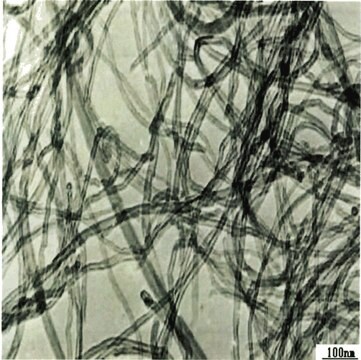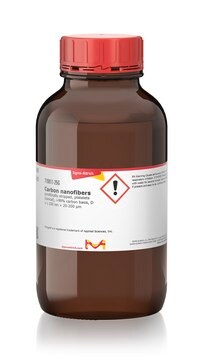901082
Carbon nanotube sheet
aligned, size × thickness 100 mm × 100 mm × 1-5 μm
Synonym(s):
MWCNT, MWNT, Multiwall carbon nanotube
About This Item
Recommended Products
Quality Level
Assay
>95% (carbon)
resistivity
10-1000 Ω/sq
size × thickness
100 mm × 100 mm × 1-5 μm
diameter
10-40 nm (carbon nanotubes)
SMILES string
[C]
InChI
1S/C
InChI key
OKTJSMMVPCPJKN-UHFFFAOYSA-N
Looking for similar products? Visit Product Comparison Guide
Related Categories
General description
CNT has a multi-walled structure. Crystal quality of CNT is examined by Raman scattering measurement. Intensity ratio of G-peak (1580 cm-1) and D-peak (1350 cm-1) represents quality of graphitization of carbon materials. G/D of CNT is ∼3, showing high crystal quality. The high crystallinity is supported by transmission electron microscopy.
Preparation Note
Storage Class Code
11 - Combustible Solids
WGK
WGK 3
Flash Point(F)
Not applicable
Flash Point(C)
Not applicable
Choose from one of the most recent versions:
Certificates of Analysis (COA)
Don't see the Right Version?
If you require a particular version, you can look up a specific certificate by the Lot or Batch number.
Already Own This Product?
Find documentation for the products that you have recently purchased in the Document Library.
Customers Also Viewed
Articles
A drawable Carbon Nanotube (CNT) array is a special type of CNT forest, in which individual nanotubes are aligned and grown vertically on a substrate through a chemical vapor deposition (CVD) process. Most strikingly, a macroscopically aligned, pure, and pristine CNT sheet can be continuously drawn out of the array, parallel to the drawing direction, as a result of a delicate interactive force established between neighboring CNTs. Carbon nanotube array has opened the door to practical applications of carbon nanotubes and multifunctional CNT composites, enabling exciting future innovations
Professor Rivnay (Northwestern University, USA) discusses using organic mixed conductors as an alternative to efficiently bridge the ionic world of biology with contemporary microelectronics.
Dr. Tan and researcher introduce recent trends in Self-healing Soft Electronic Materials and Devices. The emergence of smart, functional SHPs will be highly beneficial to the advancement of the next-generation self-healing soft electronic devices. Autonomously self-healing devices could help to minimize the need for repair or replacement of electronics and machines, potentially reducing the cost of materials and reducing electronic waste.
Graphene nanoribbons (GNRs) are quasi-one-dimensional narrow strips of graphene comprised of sp2-hybridized carbon atoms arranged into hexagonal honeycomb lattice configurations.
Global Trade Item Number
| SKU | GTIN |
|---|---|
| 901082-1EA | 4061826708187 |
Our team of scientists has experience in all areas of research including Life Science, Material Science, Chemical Synthesis, Chromatography, Analytical and many others.
Contact Technical Service





